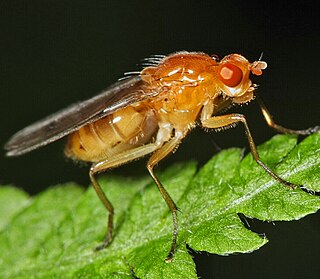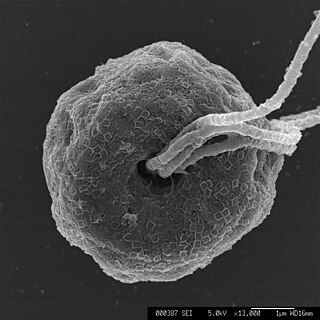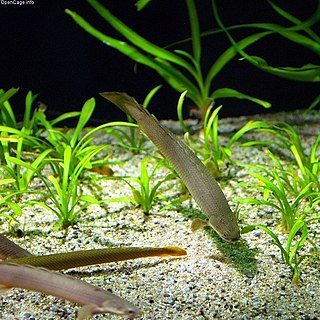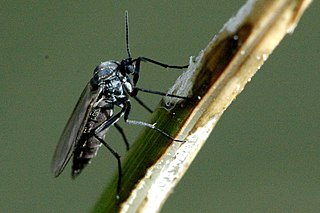
Argyra is a genus of flies in the family Dolichopodidae. The name "Argyra" comes from the Greek word for "silver".

The Dryomyzidae are a small family of flies ranging from 4–18 mm long, with prominent bristles, and yellow to brown or rust-yellow coloring. The wings are very large. The subcosta is complete and well separated from vein 1. Larvae feed on decaying organic matter - carrion, dung, and fungi. The prelambrum protrudes from the oral cavity. Vibrissae are absent and the postvertical bristles are divergent.

The Opetiidae or flat-footed flies are members of a family of flies. The family contains only five extant species in two genera, Opetia, and Puyehuemyia. the remaining taxa are known only from fossils.

Pyramimonadales are an order of green algae in the Chlorophyta.

Peridinium is a genus of motile, marine and freshwater dinoflagellates. Their morphology is considered typical of the armoured dinoflagellates, and their form is commonly used in diagrams of a dinoflagellate's structure. Peridinium can range from 30 to 70 μm in diameter, and has very thick thecal plates.
Palaeomedeterus is an extinct genus of flies in the family Dolichopodidae, known from Baltic amber from the Eocene. The genus was first proposed by Fernand Meunier in 1894 with no included species or description, though illustrations were provided for six different unnamed species.
Wheelerenomyia is an extinct genus of flies in the family Dolichopodidae, known from the Eocene of the Baltic region. The genus was first described in 1907 by Fernand Meunier, who named it after William Morton Wheeler.

Cladistia is a clade of bony fishes that currently consists of few anguilliform (eel-shaped) remnants of an ancient diversity. Their major synapomorphies are a heterocercal tail in which the dorsal fin has independent rays, and a posteriorly elongated parasphenoid.

Palomena is a genus of shield bugs of the family Pentatomidae and tribe Nezarini; species are found in Europe and Asia.
Gnoristinae is a subfamily of fungus gnats in the family Mycetophilidae. There are about 6 genera and at least 4 described species in Gnoristinae.

Lygistorrhinidae is a family of long-beaked fungus gnats in the order Diptera. There are about 7 genera and at least 30 described species in Lygistorrhinidae.

Xylophagus is a genus of flies in the family Xylophagidae. There are more than 30 described species in Xylophagus.

Sylvicola is a genus of wood gnats in the family Anisopodidae. There are more than 80 described species in Sylvicola.
Heteropeza is a genus of gall midges and wood midges in the family Cecidomyiidae. There are about six described species in Heteropeza.

Winnertzia is a genus of gall midges and wood midges in the family Cecidomyiidae. There are more than 90 described species in Winnertzia.
Ectrepesthoneura is a genus of fungus gnats in the family Mycetophilidae. There are more than 20 described species in Ectrepesthoneura.
Rymosia is a genus of flies belonging to the family Mycetophilidae.
Anaclileia is a genus of flies belonging to the family Mycetophilidae.

Tetragoneura is a genus of flies belonging to the family Mycetophilidae.
Syntemna is a genus of flies belonging to the family Mycetophilidae.











